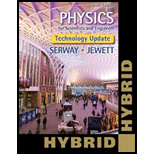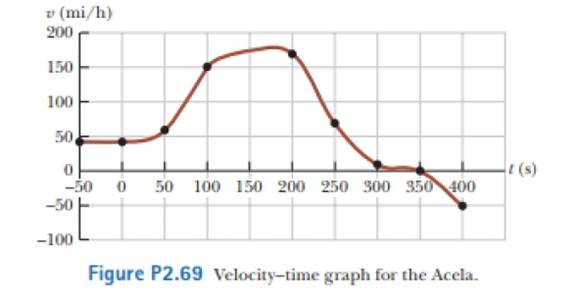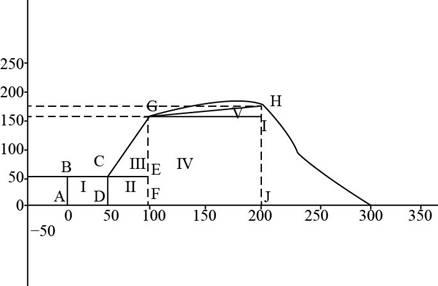
Concept explainers
The Acela is an electric train on the Washington-New York—Boston run, carrying passengers at 170 mi/h. A velocity-time graph for the Acela is shown in Figure P2.69. (a) Describe the train's motion in each successive lime interval, (b) Find the trains peak positive acceleration in the motion graphed, (c) Find the trains displacement in miles between t = 0 and t = 200 s.

(a)
The motion of train in each successive interval.
Answer to Problem 2.69AP
The train has positive constant velocity from
Explanation of Solution
Given Info: The velocity of the train is
For
The train has constant velocity of
For
The train has a linear increase in the velocity that shoes train is accelerating in the positive
For
The engineer applies brakes at
For
The train just after
Conclusion:
Therefore, the train has positive constant velocity from
(b)
The peak acceleration.
Answer to Problem 2.69AP
The peak acceleration of the train is
Explanation of Solution
Given Info: The velocity of the train is
The train has steepest acceleration from
The train starts acceleration from
The formula to calculate the acceleration of a body is,
Here,
Substitute
Conclusion:
Therefore, the peak acceleration of the train is
(c)
The train displacement between
Answer to Problem 2.69AP
The train displacement between
Explanation of Solution
Given Info: The velocity of the train is
Consider the figure given below.

Figure (1)
The area under the velocity time graph gives the displacement.
The net displacement form
From figure (1), the
The
The
The
The
The net displacement form
Substitute
Substitute
Further solve the above equation.
Conclusion:
Therefore, the net displacement is
Want to see more full solutions like this?
Chapter 2 Solutions
Physics for Scientists and Engineers, Technology Update, Hybrid Edition (with Enhanced WebAssign Multi-Term LOE Printed Access Card for Physics)
Additional Science Textbook Solutions
Conceptual Physics (12th Edition)
Introduction To Health Physics
Integrated Science
University Physics Volume 3
The Physical Universe
Physical Universe
- A runner with a good awareness of her pace runs along a path of unknown length at a speed of 0.275 mi/min and then walks back to her starting point at a speed of 0.0500 mi/min. She neglects to note her time for each part of her path, but does measure the total round trip time to be 60.0 min. How far did she run? Do not include the walking distancearrow_forwardThe velocity of a particle moving along the x-axis varies according to the expression vx = 40 – 5t², where vx is in meters per second and t is in seconds.(A) Find the average acceleration in the time interval t = 0 to t = 2.0 s.(B) Determine the acceleration at t = 2.0 s. Please use the algebraic method in solving this problem and not the calculus based method. Thank you!arrow_forwardA simple model for a person running the 100 m dash is to assume the sprinter runs with constant acceleration until reaching top speed, then maintains that speed through the finish line. If a sprinter reaches his top speed of 11.2 m/s in 2.14 s, what will be his total time?arrow_forward
- a tennis ball is thrown straight up and caught at the same height on the way down. which of the following can describe the motion of the ball when it reached its maximum height? a. The acceleration of the ball is zero b. The acceleration of the ball is 9.8 m/s^2 down c. b. The acceleration of the ball is 9.8 m/s^2 down d. The velocity of the ball is zeroarrow_forwardFor the following scenarios is there an instant when the average velocity for the time interval will equal the instantaneous velocity? a) A hockey puck slides across a frozen pond without slowing down b) a race car takes a lap at a race track at a constant speed c) a ball is thrown directly up, rises to its highest point and then falls back to the same height.arrow_forwardThe first astronaut has landed on Mars. Conducting some physics experiments, she drops a hammer from rest from a height of 2.01 m and uses a stopwatch to measure that the hammer takes 1.04 s to hit the ground. A. Determine the magnitude of the acceleration due to gravity on Mars. B. She then throws the hammer straight up into the Martian sky. If she comes back to her hand in 4.20 s, with what speed did she throw it?arrow_forward
- Referring to the figure, a truck drives a distance d=30.1m in the positive x direction in a time t1=17.2s, at which point the truck brakes, coming to rest in t2=8.13s. Part A: What is the truck's average velocity in the horizontal direction, in meters per second, during the t1 time period? Part B: Assuming the truck started from rest and moved with a constant acceleration, what was the acceleration, in meters per suqared second, during the time interval t1? Part C: What was the truck's instananeous velocity in the horizontal direction, in meters per second, when it began braking? And using the result from the previous answer, what was the truck's horizontal component of acceleration, in meters per squared second, during the braking period? Please explain how you got your answer in detail.arrow_forwardA race car starts from rest and travels east along a straight and level track. For the first 5.0 s of the car's motion, the eastward component of the car's velocity is given by υx(t)=(0.920m/s^3)t^2 What is the acceleration of the car when υx = 12.8 m/s ? Express your answer with the appropriate units.arrow_forwardA cyclist, starting from rest, travels in a straight line for 1010 minutes. During the first 2.0 min2.0 min of her trip, she maintains a uniform acceleration of 0.067 m/s2.0.067 m/s2. She then travels at constant velocity for the next 5.0 min.5.0 min. Next, she decelerates at a constant rate so that she comes to rest 3.0 min3.0 min later. Create a graph of the cyclist's velocity versus time that closely approximates her trip. The individual events of the trip are represented by the dots at the bottom of the graph. Move each dot to the appropriate velocity.arrow_forward
- A cyclist, starting from rest, travels in a straight line for 1010 minutes. During the first 2.0 min2.0 min of her trip, she maintains a uniform acceleration of 0.067 m/s2.0.067 m/s2. She then travels at constant velocity for the next 5.0 min.5.0 min. Next, she decelerates at a constant rate so that she comes to rest 3.0 min3.0 min later. Create a graph of the cyclist's velocity versus time that closely approximates her trip. The individual events of the trip are represented by the dots at the bottom of the graph. Move each dot to the appropriate velocity. Velocity (m/s)Time (min)012345678910-5-4-3-2-1012345678910 What is the acceleration ?lastalast during the last 3 min?arrow_forwardA group of students in a science class monitored the movement of a cat walking along with a straight line and recorded the cat's position in five-second intervals.The results are summarized it in the table below. time and position time(s) position (cm) 0 49.0 5 38.0 10 43.0 15 40.0 20 60.0 A. What is the displacement of the cat between t = 5.00 s and t = 20.0 s? B. What is the average velocity of the cat between t = 5.00 s and t = 20.0 s? C.What is the distance the cat traveled between t = 5.00 s and t = 20.0 s?arrow_forwardA European sports car dealer claims that his product will accelerate at a constant rate from rest to a speed of 100 km/hr in 8 sec. What distance will the sports car travel during the 8 s acceleration period? (hint : first convert speed to m/s)arrow_forward
 Principles of Physics: A Calculus-Based TextPhysicsISBN:9781133104261Author:Raymond A. Serway, John W. JewettPublisher:Cengage Learning
Principles of Physics: A Calculus-Based TextPhysicsISBN:9781133104261Author:Raymond A. Serway, John W. JewettPublisher:Cengage Learning
